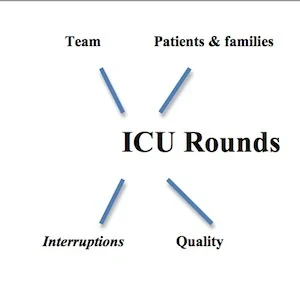Based on a survey of practice in 111 Canadian ICUs, the authors of a study published in PLOS One have recommended 5 ways to improve ICU rounds, and produced a 1 page patient care rounds guide for intensive care teams. The study was led by Jessalyn K. Holodinsky, Department of Community Health Sciences, University of Calgary, Calgary, Alberta, Canada.
1. Team Composition
The authors recommend that ICUs identify who is essential to attend rounds, make it compulsory for them to attend, define roles for each participant and create an explicit approach to the rounding process. They advise that rounds have “a standardised structure and process, include a team of provides with clearly delineated roles and be directed by a provider (regardless of profession) with strong communication and team management skills.”
2. Interruptions
Minimise and manage interruptions. The researchers suggest a multifacted approach, as interruptions occur for a variety of reasons. Solutions include provider coverage during rounds both for urgent requests and for non-urgent requests as well as education on appropriate interruptions, with a rounding tool used to safeguard abgainst missing information due to interruptions.
3. Patients and families
Additional research on the role of patients and families is needed for adult ICUs.
4. Teaching
They recommended seamless incorporation of teaching into rounds to avoid taking away from patient care, lengthening rounds or inducing provider fatigues. The ideal balance is unknown. They recommend research into frequency (proportion of patients), duration and organisation (how many teaching points per education episode), content and participants in rounding related educational activities and how these are impacted by and on patients care activities.
5. Develop a measure to evaluated ICU rounding practice quality. The researchers note the contradiction between reporting of high rounding quality but identification of many opportunities to improve.
The survey was based on a systematic review of evidence-informed ICU rounding practices. It was sent to all non-specialised Canadian ICUs, and had a response rate of 62% of Canadian ICUs. Practices were variable, with the results showing that:
Interprofessional Team
Most ICUS included attending physicians, bedside nurses, respiratory therapists and pharmacists in rounds. Survey respondents reported both positives and negatives however. For example a positive aspects was the effect on safety and quality as overlapping professional responsibility could result in catching near misses. Negative comments were lack of contributions from some team members and if it was a large team, difficulties in maintaining focus.
Time of rounds
A median of 11 patients [range 8-14] were seen on rounds per day with a median of 15 minutes [range 10 to 20 minutes] spent on each patient.
1. Team Composition
The authors recommend that ICUs identify who is essential to attend rounds, make it compulsory for them to attend, define roles for each participant and create an explicit approach to the rounding process. They advise that rounds have “a standardised structure and process, include a team of provides with clearly delineated roles and be directed by a provider (regardless of profession) with strong communication and team management skills.”
2. Interruptions
Minimise and manage interruptions. The researchers suggest a multifacted approach, as interruptions occur for a variety of reasons. Solutions include provider coverage during rounds both for urgent requests and for non-urgent requests as well as education on appropriate interruptions, with a rounding tool used to safeguard abgainst missing information due to interruptions.
3. Patients and families
Additional research on the role of patients and families is needed for adult ICUs.
4. Teaching
They recommended seamless incorporation of teaching into rounds to avoid taking away from patient care, lengthening rounds or inducing provider fatigues. The ideal balance is unknown. They recommend research into frequency (proportion of patients), duration and organisation (how many teaching points per education episode), content and participants in rounding related educational activities and how these are impacted by and on patients care activities.
5. Develop a measure to evaluated ICU rounding practice quality. The researchers note the contradiction between reporting of high rounding quality but identification of many opportunities to improve.
The survey was based on a systematic review of evidence-informed ICU rounding practices. It was sent to all non-specialised Canadian ICUs, and had a response rate of 62% of Canadian ICUs. Practices were variable, with the results showing that:
- 94% had an open approach
- 86% had a collaborative approach
- 82% had rounds at the patient’s bedside
- 81% used interprofessional rounds
- 79% started at a standard time
- 56% started at a standard location
- 48% used tools to facilitate rounds - including checklists, goal sheet or other.
- 83% welcomed patients to be present, 67% welcomed families to be present
Interprofessional Team
Most ICUS included attending physicians, bedside nurses, respiratory therapists and pharmacists in rounds. Survey respondents reported both positives and negatives however. For example a positive aspects was the effect on safety and quality as overlapping professional responsibility could result in catching near misses. Negative comments were lack of contributions from some team members and if it was a large team, difficulties in maintaining focus.
Time of rounds
A median of 11 patients [range 8-14] were seen on rounds per day with a median of 15 minutes [range 10 to 20 minutes] spent on each patient.
Rounds Tools
The authors have drafted an ICU Patient Care Rounds Guide to use in conjunction with their recommendations. The tool is a composite of items drawn up from the tools provided by responding ICUs, interviews and recommendations from checklist creating guidelines.References:
Holodinsky JK, Hebert MA, Zygun DA, Rigal R, Berthelot S, Cook DJ, Stelfox HT (2015) A survey of rounding practices in Canadian adult intensive care units. PLoS One, 10(12):e0145408. doi: 10.1371/journal.pone.0145408
Latest Articles
Rounds, Teams, ICU
Based on a survey of practice in 111 Canadian ICUs, the authors of a study published in PLOS One have recommended 5 ways to improve ICU rounds, and produced a 1 page patient care rounds guide for intensive care teams. The study was led by Jessalyn K. Holo






